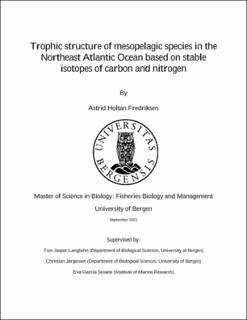| dc.description.abstract | The mesopelagic zone is one of the largest, yet among the least explored habitats of the planet. Possible estimates of fish living in this zone range from around 1 to 15 billon tones of biomass which is 10 to 15 times that of the annual global capture fisheries production. Utilizing this untapped resource can help satisfy a growing demand for food in the world. Mesopelagic spices do also play an important role in the “biological pump” by transferring of organic material from the surface water to depth. This among other reasons makes this group of species an important link in the open ocean food- webs and knowing more about the trophic structure of this species will be important. This study addresses the estimation of the trophic level as well as investigate isotopic niches and intraspecific diet pattern for mesopelagic species in the Northeast Atlantic Ocean using nitrogen and carbon stable isotope analyses. Species was collected from a transect from the Canary Islands to the Bay of Biscay. Determinations of δ15N and δ13C values were made on a total of 48 mesopelagic species including both small and large specimens. Their where six crustacean species: Acanthephyra quadrispinosa, Gennadas valens, Oplophorus spinosus, Systellaspis debilis, Robustosergia robusta and Eucopia sculpticauda and 42 mesopelagic fish species from seven families (Platytroctidae, Serrivomeridae, Myctophidae, Eurypharyngidae, Gonostomatidae, Sternoptychidae and Stomiidae). Isotope analyses on the seston was done as well to obtain an isotopic baseline for the trophic level calculations. The result shows that the mesopelagic species spans over three trophic levels from TL 1.5 to 3.2 and suggesting that the families can be coupled into three isotopic groups. As well did most species have a significant relationship between size and δ15N and δ13C which suggests that several of the species might change diet or parts of their diet as they grow. Additionally, were local environmental conditions found to be a significant predictor of δ15N and δ13C values in mesopelagic species in the Northeast Atlantic Ocean. This study also illustrates the importance of an appropriate baseline in trophic levels estimates. | |
